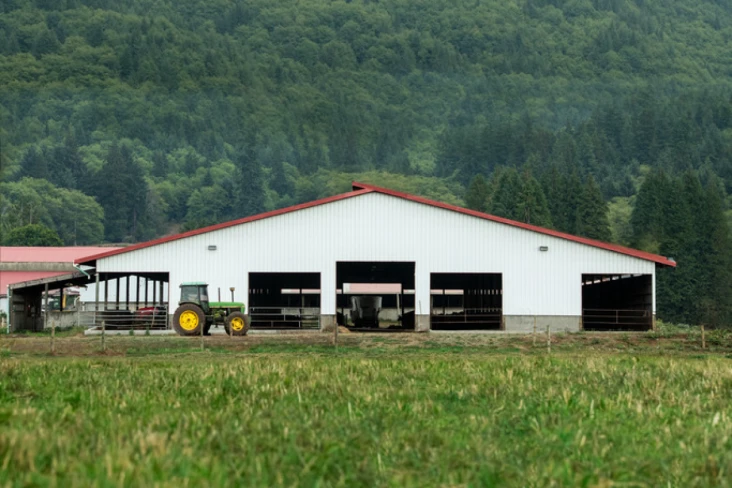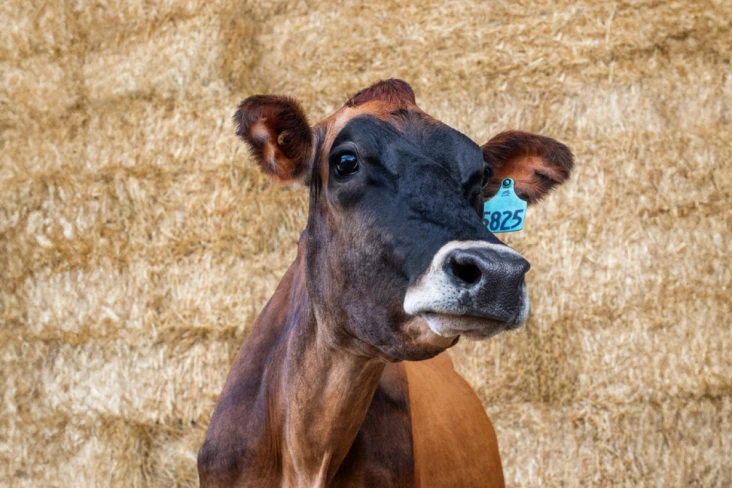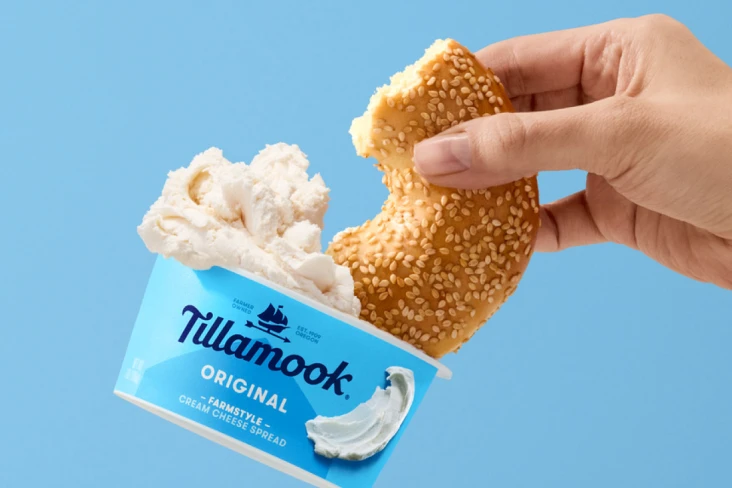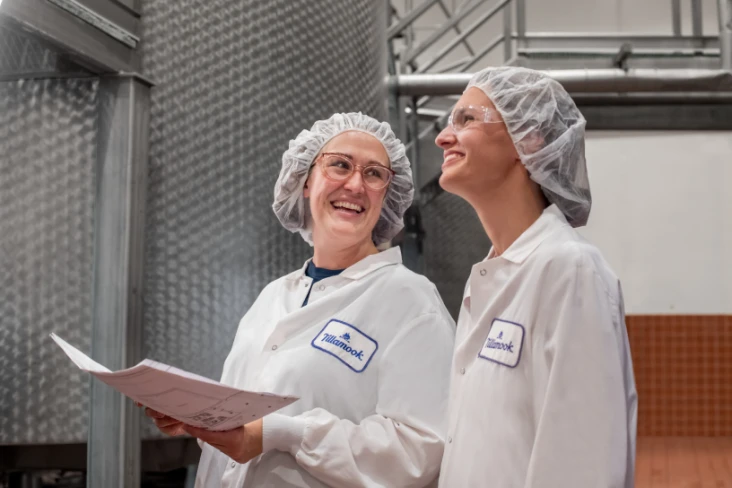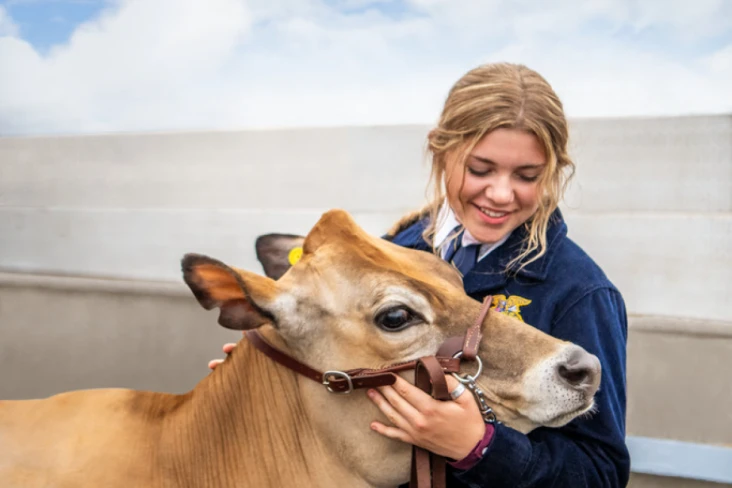At Tillamook County Creamery Association (TCCA), we generate waste along multiple stages of the lifecycle of our products, including milk production, manufacturing, packaging, distribution and consumer use. Managing our waste in a manner that maintains a clean, safe and sanitary work setting is part of our commitment to our communities and the environment.
Reducing waste and recycling material offers economic and environmental benefits. It creates jobs, conserves natural resources, saves energy, saves water, reduces pollution and reduces greenhouse gas (GHG) emissions. In particular, wasted food represents a major economic loss and produces 8% of total GHG emissions. The World Resources Institute (WRI) has calculated that if food waste were a country, it would rank third in the world in GHG emissions after the United States and China. At TCCA, we understand our responsibility to reduce materials sent to the landfill from our operations, offices, the Tillamook Creamery Visitors Center and the Tillamook Market at PDX.
One of our Stewardship Charter commitments is to Enduring Ecosystems. As part of this commitment, we have set a zero-waste target that is in accordance with the Zero Waste International Alliance (ZWIA) definition of Zero Waste. ZWIA defines Zero Waste as: “The conservation of all resources by means of responsible production, consumption, reuse, and recovery of products, packaging, and materials without burning and with no discharges to land, water, or air that threaten the environment or human health.” This and other certification systems require at least 90% diversion of solid, non-hazardous waste from landfills, incinerators and the environment.
Materials Management Policy: Our commitment to waste diversion is outlined and enforced through a company-wide Materials Management Policy, which focuses on source reduction and diversion. At a minimum, we comply with local, state and federal laws for hazardous and non-hazardous waste disposal. We uphold compliance in our manufacturing facilities by enforcing our internal Waste Management and Disposal Policy and our Toxic Use and Hazardous Waste Reduction Policy. In 2022, TCCA had zero incidents of non-compliance regarding management of hazardous and non-hazardous waste disposal.
We also use the Environmental Protection Agency (EPA) hierarchies as a guide for our preferred destinations of waste and food recovery. We refer to these guidelines as we prioritize our strategy and determine the best destination for waste streams. Some aspects of our programs, such as source reduction, may have financial implications or require a re-evaluation of pre-existing commitments within a given municipality. For example, because we work in rural areas with limited services, sometimes options such as municipal collection of compostable materials are not available. Trade-offs are evaluated on a case-by-case basis by the appropriate internal stakeholders.
Materials Audit: In 2017, we worked with Community Environmental Services at Portland State University to conduct a third-party materials audit of our production facilities. Their analyses included waste composition and diversion opportunities at each site. This information has been used to guide subsequent actions, serving as the foundation of our progress.
Key Players: In 2021, we formed a cross-functional team with employees from multiple groups at all operating locations, including: Operations; Continuous Improvement; Engineering; and our Environment and Community Impact. The team focuses on delivering waste and utility reduction through employee engagement and monthly metric analysis. Metrics reflect material waste data pulled from vendor invoices that are tracked monthly in spreadsheets and a Power BI dashboard that is updated quarterly.
Our Operations, Farm Services and Environment & Community Impact teams also track company-wide waste generation in specific categories such as landfill diversion, food waste generation and total product donation in pounds. We include this waste data in our annual environmental footprint calculations. Additionally, this includes the quantification of end-of-life impacts associated with packaging waste.
Our Operations team works to identify opportunities for improvement across our facilities. For example, in Boardman, Oregon, our Engineering team led the design and construction of a facility that separates and dries protein and lactose powders during the cheese production process. These by-products are now used in various products and supplements — a significant reduction of food waste and wastewater.
In 2020, we were invited by Kroger to participate in the WRI’s 10x20x30 Food Loss and Waste Initiative. Through this program, 10 large companies invited 20 of their suppliers to reduce 50% of 2020-level food waste by 2030. The “Target-Measure-Act” approach was pioneered by Champions 12.3, a coalition of executives from business, government and civil society dedicated to achieving the United Nations’ Sustainable Development Goal (SDG) Target 12.3 We applied the Food Loss Waste Protocol conducted our first food waste assessment at our Tillamook and Boardman facilities in 2021 to identify where food loss occurs, what kind of waste occurs and where it goes. With a baseline understanding of food waste in our operations, we continue to improve data tracking and reporting annually while taking measures to reduce food waste at our manufacturing facilities.
Following the EPA Food Recovery Hierarchy, we aim to feed hungry people with any non-saleable product we have manufactured. We support the Oregon Food Bank, schools in Tillamook and Morrow Counties and many other food-security organizations. We also regularly provide our employees and farmer-owners with short-code product (finished goods that have been deemed too close to the sell by date for retailers) as a unique fringe benefit, recognizing their contributions in making our cooperative successful.
KPI: In 2022, we donated $402,006 of product to Oregon Food Bank and other nonprofit food security organization, the equivalent of 117,608 meals. In addition, we gave our employees and member-owners over $138,999 worth of product to thank them for their service as essential workers.
If we are unable to donate surplus food for human consumption, the second level of diversion in the EPA Food Recovery Hierarchy is feeding animals. Cheese scrap from our Tillamook manufacturing facility and food waste from our Creamery kitchen is donated to local farmers to use as animal feed. In 2022, we established a new relationship at our Boardman facility to divert food scrap to an organic material upcycler that creates animal feed from regionally-sourced food waste.
When we cannot feed people or animals, we send food waste to either compost or anaerobic digestion. Currently, municipal collection of compost is only available for our Portland Outpost and the Tillamook Market at PDX.
KPI: In 2022, we diverted 1,295,329 pounds of food waste away to animal feed and 4,333,117 pounds were sent to anaerobic digestion.
At TCCA, we have recycling programs set up at each of our operating facilities to recycle and/or repurpose the following materials: aluminum cans, cardboard, co-mingle, corrugate, glass, ingredient buckets and barrels, loose office paper, paper shred, and scrap metal. All employees are encouraged to dispose of materials properly to minimize waste to landfill.
KPI: In 2022, we diverted 45% of the solid, non-hazardous waste generated at our facilities from the landfill.
TCCA recycles what is determined as hazardous waste by state and federal agencies. Our typical hazardous wastes include batteries, bulbs, electronic waste and used motor oil. All of these materials are recycled and are not sent to landfill.
Any materials that we are unable to recycle or repurpose will be sent to the landfill.
KPI: In 2022, roughly 55% of the solid, non-hazardous waste generated at our facilities was sent to the landfill.
Because we work in rural areas with limited services, sometimes options such as municipal collection of certain recyclable or compostable materials are not always available. This affects our waste-diversion performance. For example, there is no municipal compost collection in Tillamook or Morrow counties. In the spirit of continuous improvement, we are committed to evaluating our landfill pounds each year to improve our performance. TCCA actively participates in the Tillamook Solid Waste Advisory Committee, a group of local stakeholders that is creating a strategic vision for improved waste-diversion opportunities in the community.
Packaging plays a critical role in protecting the shelf life, quality and nutritional benefits of our products because it allows them to be stored, transported and consumed safely. A good package is the first step in preventing food waste, which has even greater environmental impacts than the package itself.While we promote the use of recyclable, lightweight and low-volume materials, our packaging should always fulfill its primary role: to protect food until it reaches the end consumer. Studies have shown that even an increase in packaging material can bring significant environmental benefits if it reduces food waste. Therefore, as part of our Sustainable Packaging Program, we consider the impacts of packaging and food waste together to create strategies for overall impact reduction. More information on our packaging goals can be found at our Packaging brief.
Most dairy farmers wouldn’t consider manure “waste” because it provides a valuable, organic source of fertilizer for crop production, reducing farmers’ dependency on fossil-fuel based fertilizers. In addition, our farmer-owners send about 35% of the manure generated in Tillamook County to three local biodigesters.
Threemile Canyon Farms, the key milk supplier for our Boardman plant, has created a closed-loop farm; this means the dairy and crop farms continually sustain and improve one another. Cow manure is sent to an on-site methane digester that converts waste into clean, renewable natural gas. In addition to providing renewable natural gas, it also provides nutrients that go back into crops, which in turn feeds the cows and improves air quality. The digester sequesters around 136,000 metric tons CO2e per year.

U.N. Sustainable Development Goals

Goal 2
End Hunger, Achieve Food Security and Improved Nutrition, and Promote Sustainable Agriculture
By donating short code product to food banks, we reduce food waste while helping end hunger in the U.S.
